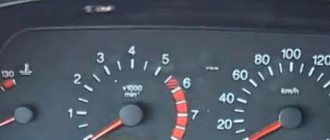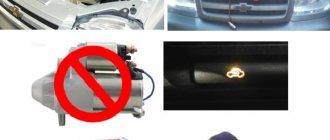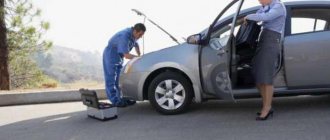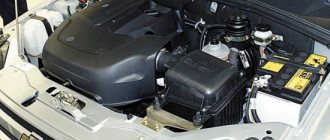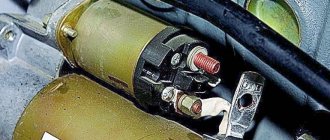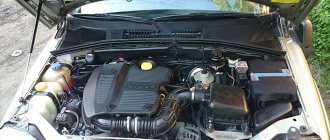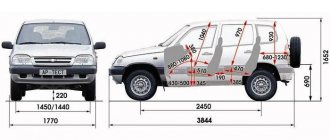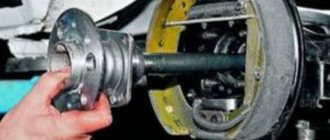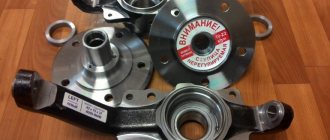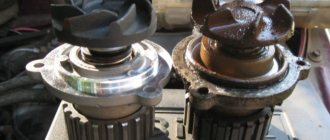Chevrolet - Niva, the elusive module.
I got a call, my Chevy Niva car won't start. On site, the owner explains that at first it sometimes crashed spontaneously, after a while it started up and could work normally for a few days to a few weeks. Then the cases became more frequent, and as a result, while parked, the engine flatly refused to start.
I'm trying to connect diagnostic equipment, but there is no connection with the engine control unit. Together with the owner, we decided to tow the car to a service station. In the end, I decide to try to restart, and lo and behold, the engine starts with half a turn, as if nothing had happened. Okay, let's go together. On the floor - it froze again on the way, we had to be towed. On the way, I’m already wondering what it could be: alarm, wiring, power, crankshaft sensor? And almost before the gate everything ended just as unexpectedly. So I went to the workshop alone.
First I reconnect with the control panel. Due to the disabled immobilizer, diagnostic line K hung in the air. I install the jumper, there is a connection! The Bosch MP 7.0 control unit has not registered any error codes in its memory. I turn on the engine, the parameters are ok, it works fine. So they usually check the power source, masses, time, fuel pressure, and take oscillograms. Everything is fine, there are no deviations. This always happens. I'm taking a wait-and-see approach; sooner or later a technical problem will show itself. What I didn’t do, warmed up, cooled down, drove at high speeds and idling, started and stopped, knocked on the wheel, but the engine worked properly, not wanting to reveal its secret.
And finally, in the evening, after 6 hours of almost continuous monitoring, the engine stopped starting. I quickly look at the parameters on the scanner - there are no errors or deviations. There is fuel pressure, a signal is sent to the injectors, but there is no spark. There is a hint. The signal from the crankshaft sensor goes to the ECU, there is power and ground on the ignition module, does this mean that the module itself remains? I think it's impossible for both module channels to fail at the same time. I connect an oscilloscope, there is control from the unit, which means the module itself is faulty! I put the new one in and the engine ran fine.
Here is such a mysterious module, I want it to work, but I want it not to work. Because its design doesn't fold, it keeps its secret in a trash can
It happens that the starter works normally, but the engine stubbornly refuses to start, although the Check light is not on. In such cases, if we talk about the VAZ-2123 engine, we can immediately name 10 different reasons. All of them will be quite real and not at all from the category of “oxidized contacts”. In general, sometimes the Chevrolet Niva does not start, but the starter turns the shaft regularly and there is no need to look for the reason. Well, let's try to learn to recognize different reasons, that is, to distinguish one from the other.
Example in the video: the APS immobilizer blocked the engine because it was in learning mode!
Why the Chevrolet Niva does not start: the starter turns, but the engine does not catch
It happens that the starter works fine, but the engine stubbornly refuses to start, although the Check lamp does not light up. In such cases, if we talk about the VAZ-2123 engine, we can immediately name 10 different reasons. All of them will be quite real, and not at all from the category of “contacts have oxidized.” In general, sometimes the Chevrolet Niva does not start, but the starter turns the shaft properly, and the reason should not be looked for there. Well, let's try to learn to recognize different reasons, that is, to distinguish one from the other.
Example in the video: the APS immobilizer blocked the engine because it was in learning mode!
Chevrolet Niva does not start: three different sensors
The crankshaft position sensor will not indicate its failure in any way. The Check light will not light up, the engine will simply not start. Finding this sensor is easy if you know where the alternator belt is (see photo).
DPKV sensor connector
Here we check the serviceability of the wiring, as well as the distance from the sensor to the “teeth” (0.8-1.2 mm).
The second suspicious element will be the temperature sensor. The engine may not start only if it breaks. In this case, the electric fan should work without turning off. That is, a break in the DTOZH sensor circuit is easily recognized.
Element “6” is DTOZH
In the photo there is a sensor, and to get to it, the air duct is removed.
If the idle speed control malfunctions, the engine on a Chevrolet Niva does not start, but the starter turns. By the way, the Check lamp may be on. Diagnostics:
- Just lightly press the gas and turn on the starter;
- If the engine starts, but without gas it does not start, it means the IAC is faulty.
Set of "electrical" reasons
The first step in diagnostics: remove the cap from any spark plug, install spark plug A17DVRM and, holding it with pliers, turn on the starter.
How to remove the cap
The spark plug must be held by the hexagon, the pliers must have insulated handles, and the spark plug body must touch the “ground”. As a result, a spark can be observed. If there is no spark, it means:
- The ECM is faulty or is not receiving voltage;
- The ignition coil module burned out;
- High voltage wires are faulty.
The drawing for point “1” is given below.
Power supply point to the ECM
The presence of a spark “in the air” does not guarantee its presence in the engine. The spark plugs may be faulty, the gap may be incorrect, etc.
The number of reasons why the Chevrolet Niva does not start, but the starter turns, has increased to 7.
Immobilizer blocks engine starting
If the immobilizer has been activated, then sooner or later it will block the engine from starting. It happens like this: when you turn on the ignition, the indicator flashes for 15 seconds, then goes out. And then the system produces sound signals.
“2” – immobilizer lamp
The APS-4 module can be disabled. For this you need a “red” training key. Well, the APS-6 unit cannot be turned off. Usually you have to flash the ECM.
There is no need to panic right away: perhaps the blocking occurs due to irregularities in the “reader” wiring.
No spark at the injector
If the engine does not start, but you can hear the fuel pump in the tank turning on and running, in this case the spark on the injector most likely has disappeared.
To determine the malfunction, you need to check for the presence of a spark discharge on high-voltage wires. In this case, be sure to use a spark gap. If you check for a break in the presence of a spark by placing the wire at a certain distance from the ground of the car, the ignition module or controller may fail due to the appearance of a large self-induction current with a large spark gap. In addition, you can get quite noticeable and unpleasant sensations when receiving an electric shock when the insulation breaks down. In the case when you check the spark discharge by placing a spark plug with a high-voltage wire on it on the engine body, also due to poor contact of the spark plug body with ground, a large self-induction current can form, which will lead to damage to the controller or ignition module. The use of a spark gap is also more convenient, since most injection engines use static ignition distribution with the simultaneous supply of high voltage to two spark plugs. It is not difficult to make a spark gap yourself; here you can find several examples.
A drawing of a spark gap for simultaneously checking a spark on four high-voltage wires and a photo for checking a spark on two high-voltage wires. After connecting the spark gap, crank the engine with the starter and observe the presence of a spark discharge. If the spark on the injector on one wire disappears, when high voltage is distributed simultaneously to two spark plugs, then this indicates a breakdown to ground of the wire or the output of the ignition coil (ignition module). If there is no spark at the same time on a pair of wires 1-4 or 2-3, then the ignition coil, ignition module or controller is faulty. Breakage of high-voltage wires also cannot be ruled out.
Checking ignition devices.
To check the integrity of high-voltage wires, it is necessary to check their resistance; it should not exceed 200 kOhm, and there should not be a large difference in resistance in a set of identical wires. To check the ignition coils or module, you need to check for the corresponding error codes in the controller's RAM. If the controller does not have a diagnostic function for the module or coils, then the easiest way is to replace the module with a known good one and repeat the test. If in this case there is no spark on the same wires, then the controller or the wires connecting it to the ignition coil (module) are faulty. When checking the presence of a spark discharge in a static ignition system with an ignition coil on each cylinder, if there is no spark on one of the coils, replace it with any serviceable one from any cylinder. If a spark appears, the coil is faulty, otherwise the controller or the wire connecting it to the coil is faulty. In the case when there is no spark discharge on any wire, it is necessary to check the presence of power on the ignition coil, and when using a module in the ignition system, also the presence of a minus. For example, on cars with an MP7 controller, you need to check for the presence of a plus on wire 68 by touching it with a test lamp connected to the minus and the presence of a minus on wire 66, with a test lamp connected to the plus. If the supply wires are in good condition, you need to check the serviceability of the crankshaft position sensor. This can be done in several ways, depending on the controller used and the vehicle. After turning on the ignition and stopping the fuel pump, if we start cranking the engine with the starter, if the sensor is working, the pump should turn on again. But it must be taken into account that some controllers turn on the fuel pump only when certain crankshaft speeds are reached. You can also connect a test lamp to the terminals of any injector. In this case, during rotation of the crankshaft, if the sensor is working, the warning lamp should flash. If the sensor is working, then the controller or the wires connecting it to the ignition coils or module are faulty. Evidence of the operation of the crankshaft position sensor can be provided by damp spark plugs removed from the engine cylinders. A controller malfunction in 99% of cases is associated with a breakdown of the control key (transistor), which connects the primary winding of the ignition coils to the minus. This is the same main reason for the malfunction of the ignition module. But if the ignition module is filled with compound and is practically beyond repair, then the controller can be repaired in this case. In some cases, anyone with soldering iron skills and a little knowledge of electronics can handle this. A sensor malfunction is quite a rare occurrence and is often associated with loss of contact in the plug connection to the sensor, due to its contamination and oiliness, and a break or short circuit of the wires, due to improper installation during repairs.
If during the check it is determined that a spark is supplied to the spark plugs, but the engine does not start, then read the article “Injection engine does not start”
Fuel rail
On the ramp next to regulator 5 there is a control fitting 3. It is closed with a cap, which is unscrewed and then carefully pressed on the spool.
If fuel flows, it means it is entering the ramp. But perhaps the necessary pressure is not created. Reasons: clogged filter cylinder, pump malfunction, etc.
The pressure should be 350 kPa (3.5 bar). It is controlled by unscrewing the spool and installing a pressure gauge. Before checking, you need to reduce the pressure!
If fuel does not flow, notice whether the pump turns on when the key is turned to the “I” mark. When the ignition is turned on “cold”, the pump should run for 10 seconds.
Additional mounting block
Know that fuse F2 and relay P4 are responsible for turning on the pump. There is also a main relay P5, and all these elements are located in a block mounted on the same bracket with the ECM (see photo).
Even if the pressure is normal, the injectors may be clogged. In addition, their wiring may be damaged.
Case from practice
What happens if water gets into gasoline? In the summer - nothing. And in winter, the power supply system can become clogged with ice. All elements are at risk, from the pump to the injector valves!
The main reasons why there may be no spark
- First of all, make sure that there is no dust, dirt, oil stains, etc. on the ignition system elements. If any of the above is present, take a rag and wipe everything thoroughly, or blow it out with compressed air, and then try to check the spark again and start the engine.
- The spark plugs are faulty (“flooded”, insulator burst, breakdown, etc.). Check the spark plugs individually and make sure there really is no spark. If there is no spark on all the spark plugs, then the reason is most likely not in the spark plugs, but in the coil or, for example, the starter. Read: how to check the starter here. If there is a spark, but it is weak or yellow, check the coil or BB wires.
- The problem is in high voltage wires (HV wires). This could be a break, a ground fault, or poor contact. Carry out a detailed inspection of the explosive wires, make sure that there are no cracks or fractures on their surface. Move the wires and try to start the engine, if the engine starts or at least tries, most likely the reason lies in the wires. Details on how to check BB wires.
- Malfunction of the ignition module or ignition coil. how to check the ignition coil here.
- The crankshaft sensor has failed, read here how to check.
- The problem is in the switch, distributor, incorrect clearance, burnt contacts.
- There is no contact on the ground wire or it is very bad.
- ECU malfunctions.
Methods for checking spark on spark plugs:
Details on how to check spark plugs.
Electrical faults
There are quite a lot of components of electrical equipment for a Chevrolet Niva car. Sometimes, in order to find the cause of a breakdown, you have to check all the components one by one. However, the experience of car enthusiasts allows us to identify the most vulnerable elements that cause the malfunction.
- The battery is low. It may fail due to long service life.
- Starter malfunction.
- Lack of contact at the battery terminals.
- Lack of spark (malfunction of spark plugs, power wires, ignition module).
- Fuse blown.
- Ignition switch malfunction.
- Errors in the immobilizer operation.
Fuel system malfunctions
Even if fuel is supplied, but its pressure is not high enough, this may be the reason why the Chevrolet Niva does not start. Taking this fact into account, we will highlight the main malfunctions characteristic of cars with injection injection.
- Fuel pump malfunction.
- Fuel filter clogged.
- Clogged injectors.
Let us remind you that the most probable causes of failure are listed. It may be necessary to carry out further and more detailed diagnostics using special equipment. But if there is an opportunity to fix the problem yourself, the desire to take advantage of it is quite understandable. In addition, it is not that expensive financially.
Mechanical faults
Reasons caused by the mechanical part of the car include: clogging of the fuel filter or fuel pump, which causes both elements to fail; clogged injectors; running out of oil in the engine or coolant in the radiator. The last reason is very dangerous, as this can cause the power unit to overheat and fail. It’s rare, but it still happens that the engine does not start due to running out of gasoline, because the driver did not keep track of its level, or because of a broken fuel sensor.
Troubleshooting electrical equipment
Battery
The battery rarely discharges suddenly. Often starting becomes difficult due to low starter speed. But there are also cases when the battery dies in a very short time. When you turn the ignition key, the dashboard may “come to life”, but when you try to turn on the starter, all the lights go out. This is an indicator of battery discharge. As a last resort, you can turn on the headlights and judge the condition of the battery by the brightness of the lamps. The way out is to charge the battery or replace it.
Starter
If the battery is in order, and clicks are heard when you turn the key, then they indicate a fault with the starter. If nothing happens (no reaction), then before sinning on the starter, you need to check the reliability of the connection of the supply wire to the starter solenoid relay. If the starter has become unusable, then its repair is possible, but it depends on the reasons, of which there may be several.
How to troubleshoot problems on a Niva Chevrolet
| Sign | Elimination |
| The starter rotates but the flywheel does not move. | Wear of flywheel teeth cannot be prevented. Installing a new |
| The starter rotates very slowly and engages intermittently | Low battery voltage. Recharging, replacement. |
| The starter does not turn over in cold weather | The battery is severely discharged and has become unusable. Installing a new |
| The engine starts the second and subsequent times when cold. | Unstable supply of current, spark, fuel. It is necessary to comprehensively check the fuel system, as there can be many reasons |
| The engine takes a long time to start when hot and then immediately stalls. | Clean the throttle valve, check the fuel filter, fuel pump |
| The immobilizer lamp lights up on the dashboard, indicating a breakdown in the power system. | Check the tension of the drive belt, the reliability of the generator, contacts, terminals |
| When starting the engine, a metallic grinding or creaking noise is heard. | Most likely the shaft bearing is worn out, the spring is deformed, the flywheel teeth are damaged |
Regardless of the type of breakdown or the availability of technical equipment maintenance skills, use the services of a service station, where they provide a quality guarantee for the work performed.
Independent intervention in repairs does not always bring positive results. Use the services of handicraft workshops less often.
Troubleshooting the fuel system
First of all, you should make sure that the fuel pump is working. When you turn on the ignition, a humming sound should be heard from under the rear seat for a while (within a few seconds). It would be a good idea to measure the pressure in the fuel rail. A special fitting is provided for this. Low pressure may be due to a malfunction of the regulator located in the pump block. Usually this block is changed entirely.
The fuel filter is changed according to regulations. It should be replaced at the first suspicion. Even if it turns out not to be the problem, you still need to change the filter.
With injectors the situation is more complicated. They are checked at a special stand. But injectors often cause difficult starting, and they can become clogged all at once. Typically, if an injector is faulty, the check engine light will come on. Faulty injectors must be replaced.
To summarize, if the Chevrolet Niva does not start, it is worth conducting initial diagnostics yourself. Perhaps this will help avoid high service costs.
Source: chevniva.ru
VAZ 21214 no spark
Hello forum users. There is a NIVA 2123 engine. 2123 ECU BOSCH. I don’t know which one exactly, I was only able to see this: There is no alarm on the car, no one has ever touched the immo, it’s as if it was off. The problem is this: it won't start. The starter vigorously turns the crankshaft, the check engine light goes out after it starts cranking. When you turn on the ignition, you can hear the fuel pump whirring, then the relay clicks. Everything seems to be as usual here. I tried to unscrew the spark plug - after driving with the starter it was wet.
I checked the spark, inserted the spark plug into 3 of the 4 explosives, there was no spark. That is, it turns out that all 4 lines do not work. The engine doesn't even try to catch, that is, there is no hope of a spark. I changed the DPKV - it didn’t help, the pump hums, there is no spark. True, I noticed that the new sensor differs from the old one: the shape of the nose, the old one is rectangular, and the new one is cylindrical. Is this critical? I don’t remember the numbers on them right now, but they have different markings. before the dot the numbers are different, but after the dot they are the same.
That is, the old aaa sensor. yyyyyyy and the new bbb. yyyyyyy. If necessary, I can tell you exactly their markings. Although I think if the sensor didn’t work, then the pump wouldn’t even pump gasoline. 1) is it possible to find out from that information what the ECU is and its true marking of the type 2123-14110. To make it easier to find what goes where and how in the future. 2) what to do now, how to look for the culprit, where to start?
Electrical reasons
First of all, you need to remove the cap from the spark plug (any one) and install spark plug A17 DVRM. Holding it with pliers, turn on the starter.
To remove the cap, hold the spark plug by the hexagon (pliers with insulated handles are suitable). It is necessary that the spark plug body touches the “ground”. As a result, you will be able to see a spark. In the case where there is no spark, this indicates:
- malfunction of the ECM or lack of voltage;
- combustion of the ignition coil module;
- damage to high-voltage wires.
Checking for spark
Let's say your fuel-injected car has stopped responding to the ignition key and refuses to start. It is quite irrational to immediately complain about a malfunction in the ignition system. First of all, you need to make sure that it is the spark that has disappeared and not something else that has broken. To check spark plugs for the presence of the coveted “light”, you can resort to several procedures at once. Perhaps the most effective and simple ones are the following:
- The first method is a mass test. To implement it, you need to turn off the ignition, unscrew each spark plug in turn and, placing its body against ground (the metal body of the engine), try to start the engine;
- The second method is checking with a multimeter or a tester based on a piezoelectric element. This diagnostic option is quite similar to the method described above, except that the spark plug is applied not to ground, but to the contacts of the tester or multimeter. However, in this case there is no need to “turn” the starter; the spark must come from the devices themselves.
The immobilizer blocks engine operation
When the immobilizer is activated, one way or another, it will block the engine from starting. This happens when, with the ignition on, the indicator starts flashing for 15 seconds and then goes out. Next, the system sends sound signals.
It’s time to disable the module on the Chevrolet Niva APS-4. Here you will need a training key (red), but APS-6 cannot be turned off. Basically, the ECM is forced to flash. There is no need to panic: the blocking is probably due to a broken reader in the cable.
A little about the fuel rail
There is a control fitting 3 on the ramp with regulator 5. The latter is hidden by a cap; you need to unscrew it and carefully press the spool. Fuel poured out - therefore, it entered the ramp. However, it is possible that the required pressure is not generated. The reasons may be clogged filter cylinder, damage to the pump, etc.
The pressure must show 350 kPa, that is, 3.5 bar. To control it, unscrew the spool and then install a pressure gauge. On the eve of the test, you should reduce your blood pressure. If there is no fuel supply, you need to pay attention to whether the pump turns on or not when turning the key to the “I” mark. When cold, the pump should operate for 10 seconds with the engine running.
Note: What happens when there is water in gasoline? In the summer - nothing. But in winter, the food system sometimes becomes clogged with ice.
Fuel supply filter
There is always a small amount of moisture in the fuel. When this amount is increased, this is what can happen:
- the first start always goes without problems;
- After leaving the car in the parking lot, after 2-3 hours the driver will no longer be able to start the engine without repairs.
Everything mentioned should be attributed to the injection internal combustion engine. And here the fuel filter will be a candidate for failure. So, in the Chevrolet Niva it is located under the bottom in aluminum form. By the way, this is thought out on many machines.
Pumping up excess air
As you know, a Chevrolet engine sometimes does not want to spin because too much air is drawn into the intake manifold. Therefore, it is worth checking the fixation of all pipes and more.
The cause of excess air is damaged VUT. The engine on a Chevrolet Niva does not start while the starter is turning, which means you need to look for the problem in the brake system. But you can do it simpler:
- remove the vacuum supply hose (from the amplifier side);
- close the hose gap with your finger by performing a test run;
- the engine starts, which means the problem has been found.
Despite its apparent simplicity, damage to the air supply is difficult to see. It is worth checking how the hoses are seated on the fittings and making sure the clamps are tight.
Finding out the cause
So, most often the Niva-Chevrolet does not start the first time due to damage to the electronics or mechanical part of the car. But how do you understand which element has failed? After all, there are quite a lot of options to check, and you could spend the whole day checking them all. You can find out the reason by carefully inspecting and studying all the elements, as well as using the hints that the car itself gives.
A specialist will help you figure out why it’s not cold much faster. He will come to the site of the breakdown himself and find out the cause quite quickly with the help of special equipment and tools. However, you will have to pay a considerable amount of money for such a service. You can make this process cheaper if you tow the car to the nearest service center. This service will be less expensive financially, but will take more time.
Why doesn't the Niva-Chevrolet start when hot? To save money, you can find out the cause of poor engine starting yourself. It is necessary to resort to the help of specialists only if all possible components and mechanisms have been checked and are in good condition, but the engine still does not start. In this case, only special equipment will help.
Damage to the starting system
Failure may manifest itself in improper operation of the starter device. Let us highlight 5 main malfunctions of this mechanism:
- The starter does not turn. The reason lies in a violation of the contact units, a break or short circuit in the starter circuit, or damage to the traction relay.
- When starting the starter on a Chevrolet Niva, there are repeated clicks. This indicates a malfunction of the traction relay, which is held by the winding, a discharge of the battery, or loose contact connections in the starter circuit.
- The starter starts, but the armature either does not rotate or rotates slowly. The cause may be a discharged battery, broken contact connections, burnt contacts of the traction relay, worn brushes, dirty commutator, interturn/short circuit of the windings.
- The starter turns on, the armature rotates, but the flywheel does not move. The problem may be loosening of the starter to the clutch housing, breakage of the flywheel teeth or drive gear. This would also include slipping of the freewheel of the drive and damage to the lever.
- The starter does not turn off after starting the Chevrolet Niva engine. The reason is a malfunction of the freewheel of the starter device, sintering of the contacts of the traction relay. If this damage occurs, stop the engine immediately.
The above reasons require the intervention of specialists at a service station or upon arrival at an equipped garage. You can only check in advance with a voltmeter how discharged the battery is, and also pay attention to the tightness of the contact connections in the starter circuit.
Source: ladaprofi.ru
Bringing the car back to life
As for why a spark disappears, everything is probably very clear. Now, it would not be amiss to consider the order of her return. The reality is that in most cases, getting the spark back is a simple matter and just involves carefully checking the broken car. To be more precise, to normalize sparking it is required:
- Firstly, check the spark on the injector using the method described above, make sure that it has disappeared, and, at least indirectly, try to determine the cause of the malfunction;
- Next, it is enough to assess the current circumstances and act based on them. As typical situations, we suggest considering solutions to the following problems:
- the spark plug is wet, the presence and strength of the spark are unimportant, the carbon deposits are correct (brick color) - wipe the part and screw it back in;
- the spark plug is wet (not always) and the carbon deposits are incorrect (white or black) - clean, dry the part and try to start the engine, if there is no result, change the spark plug and deal with problems in the fuel system (cleaning the injector, checking the ECU, etc.);
- the spark plug is wet, there is no spark at all, the color of the soot is not important - we try to change the part, if there is no result, we check the ignition system and the operation of the injector.
In principle, in theory there are no particular difficulties in repairs of this kind. Despite this, it often causes difficulties in implementation for inexperienced motorists. To solve these, you need to act in the order described above, but if something doesn’t work out, it’s better to turn to professionals at a service station. This approach to repairs will not only save time, but also guarantee trouble-free operation of the car in the future.
